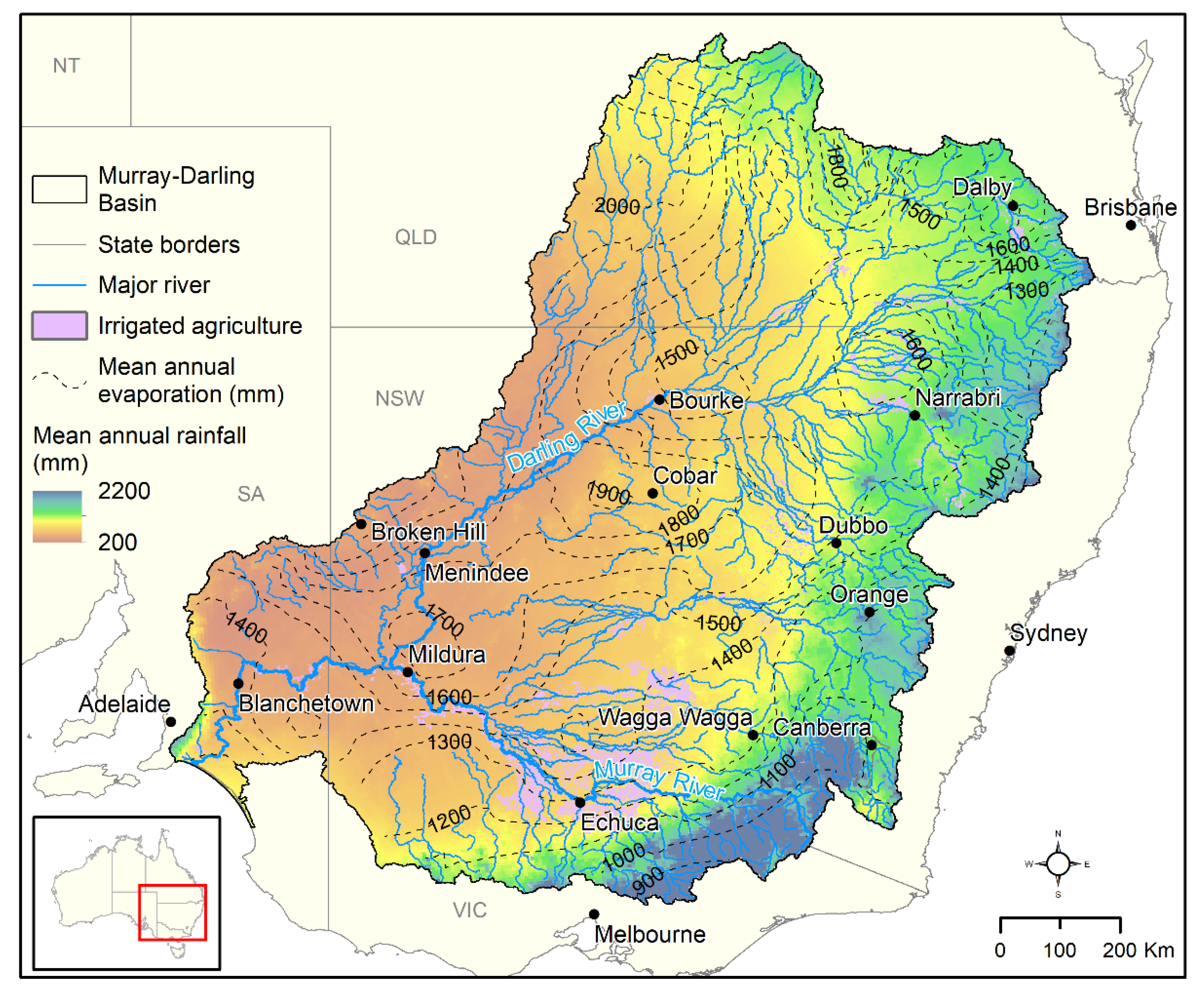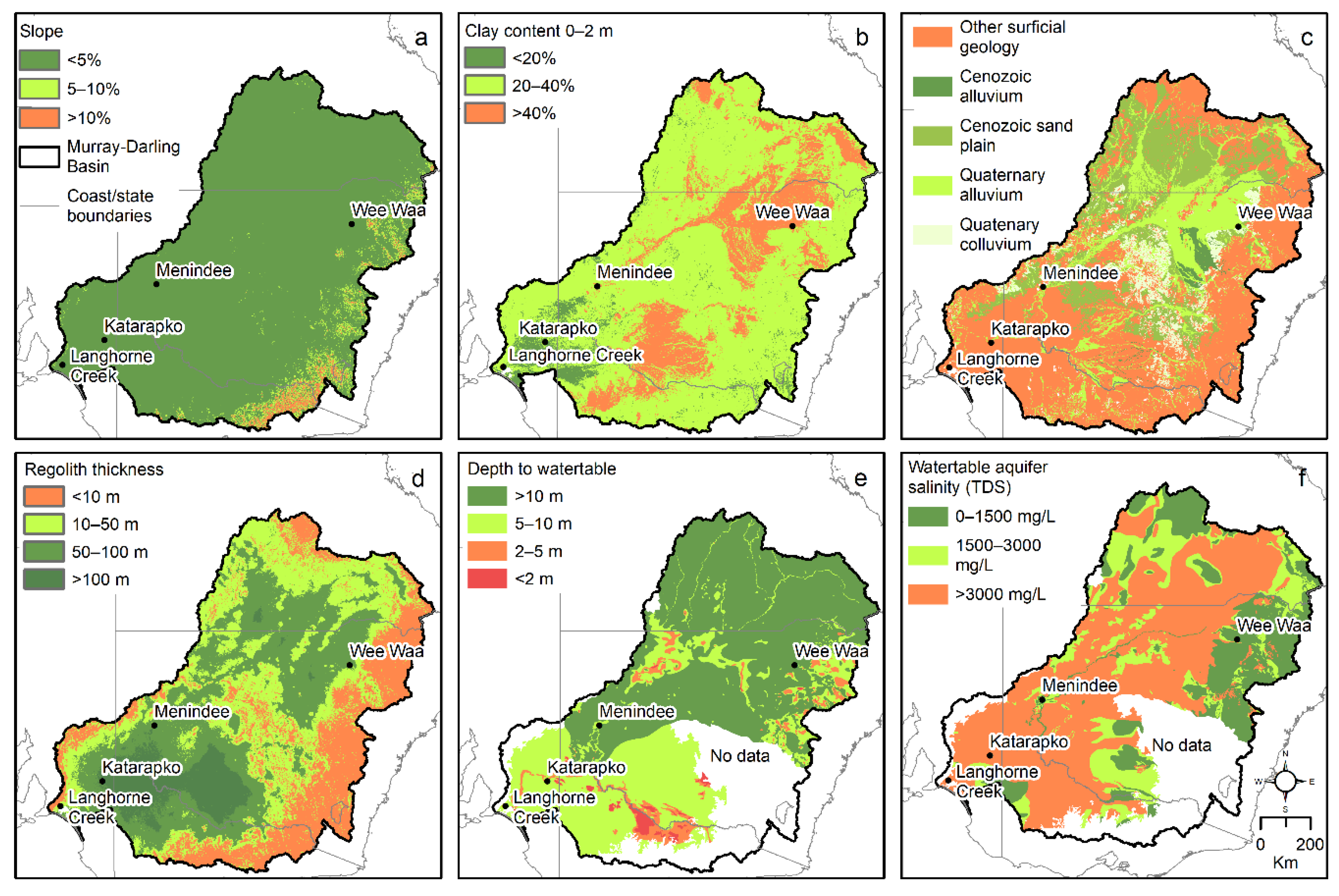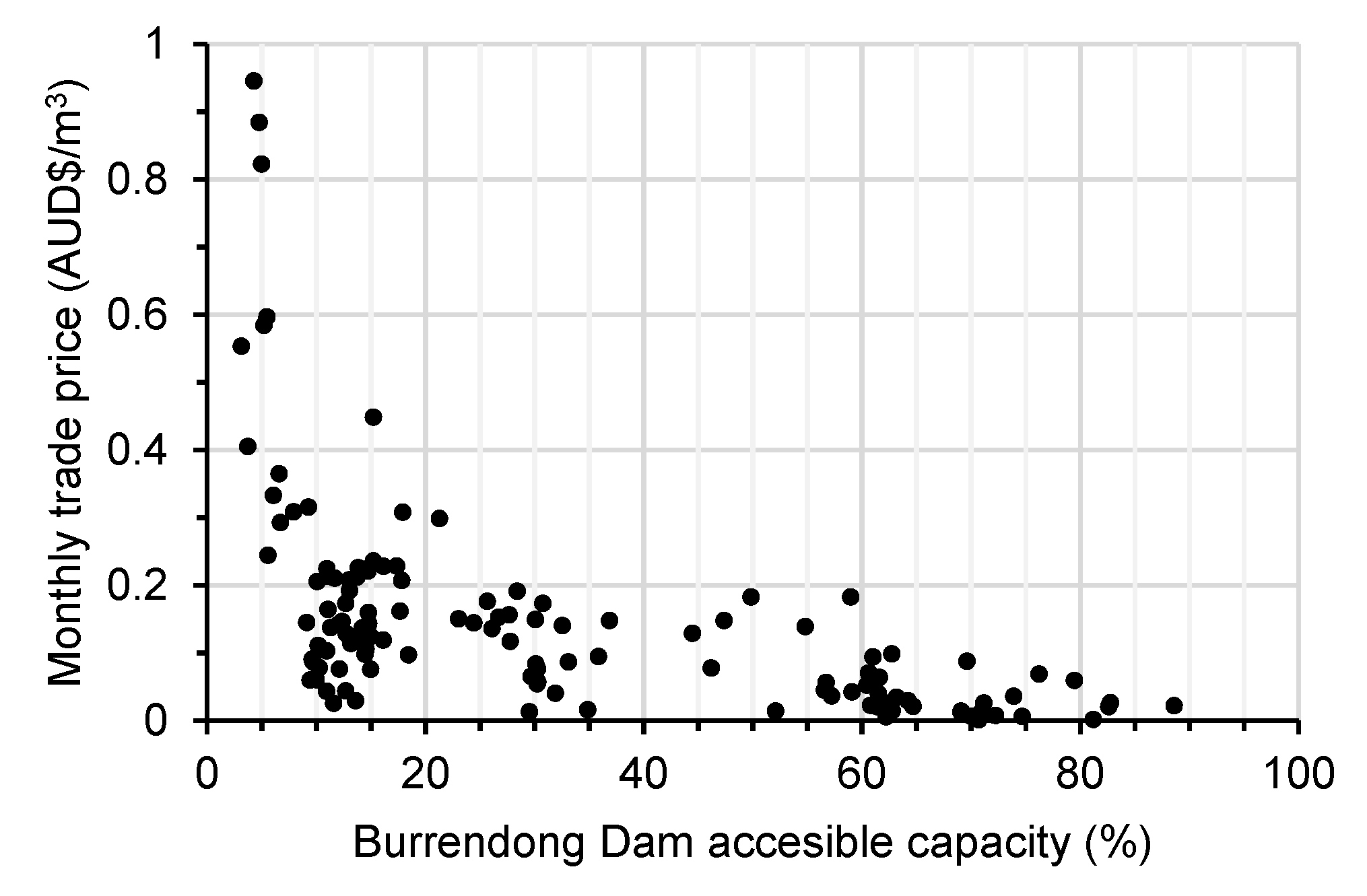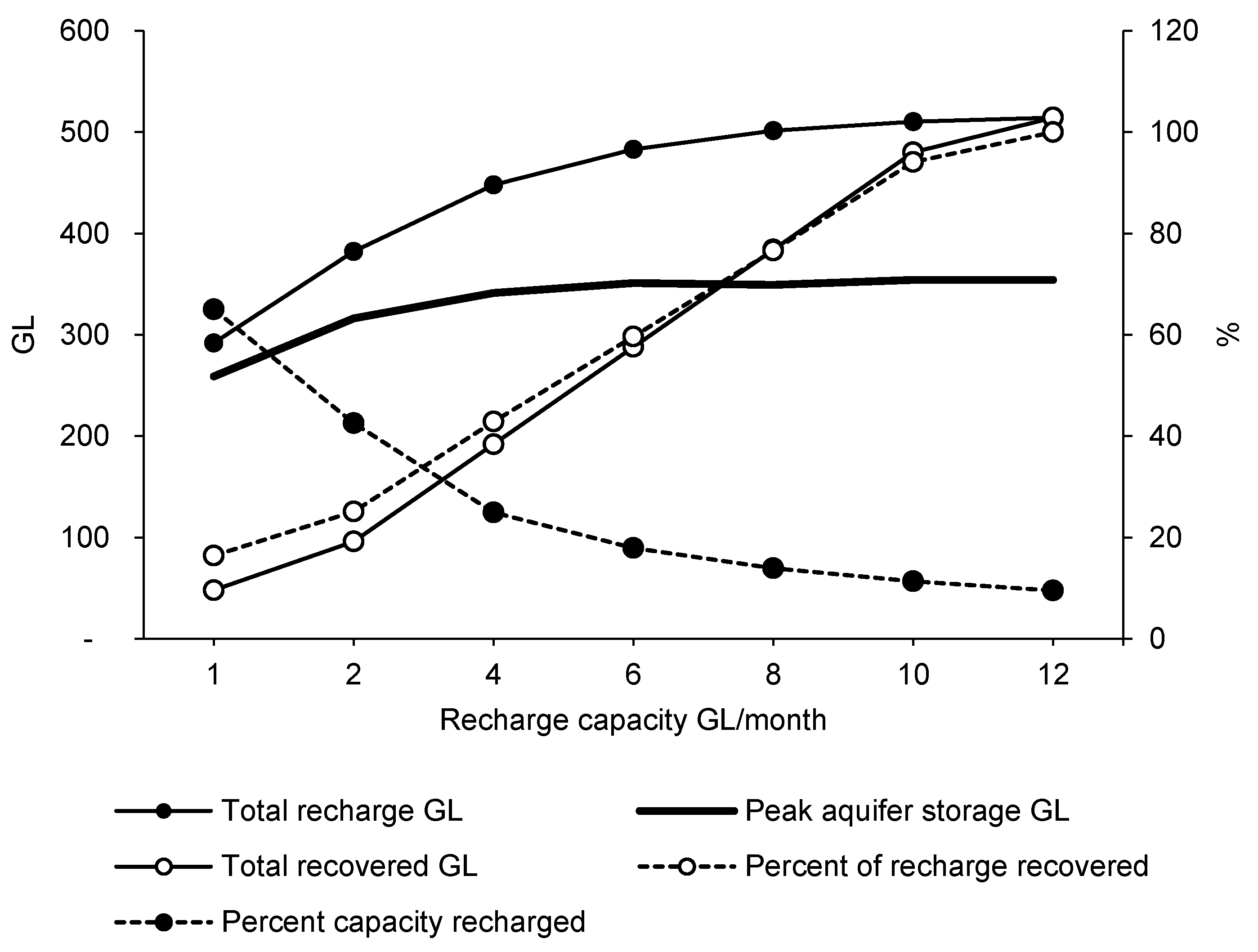The Potential for Water Banking in Australia’s Murray–Darling Basin to Increase Drought Resilience
Abstract
:1. Introduction
2. Materials and Methods
2.1. Murray–Darling Basin Overview
2.2. Regional Aquifer Storage Potential Assessment
2.3. Sub-Catchment Recharge Simulation
3. Results and Discussion
3.1. Regional Aquifer Storage Potential
3.2. Sub-Catchment Recharge Simulation
4. Conclusions
Author Contributions
Funding
Acknowledgments
Conflicts of Interest
References
- Dillon, P.J. Australian progress in managed aquifer recharge and the water banking frontier. J. Aus. Water Assoc. 2015, 42, 53–57. [Google Scholar]
- Megdal, S.B.; Dillon, P.; Seasholes, K. Water Banks: Using Managed Aquifer Recharge to Meet Water Policy Objectives. Water 2014, 6, 1500–1514. [Google Scholar] [CrossRef] [Green Version]
- Craig, I.; Green, A.; Scobie, M.; Schmidt, E. Controlling Evaporation Loss from Water Storages; Publication University of Southern Queensland: Toowoomba, Australia, 2005. [Google Scholar]
- Helfer, F.; Lemckert, C.; Zhang, H. Impacts of climate change on temperature and evaporation from a large reservoir in Australia. J. Hydrol. 2012, 475, 365–378. [Google Scholar] [CrossRef] [Green Version]
- Scanlon, B.R.; Faunt, C.C.; Longuevergne, L.; Reedy, R.C.; Alley, W.M.; McGuire, V.L.; McMahon, P.B. Groundwater depletion and sustainability of irrigation in the US High Plains and Central Valley. Proc. Natl. Acad. Sci. USA 2012, 109, 9320–9325. [Google Scholar] [CrossRef] [Green Version]
- Scanlon, B.R.; Reedy, R.C.; Faunt, C.C.; Pool, D.; Uhlman, K. Enhancing drought resilience with conjunctive use and managed aquifer recharge in California and Arizona. Environ. Res. Lett. 2016, 11, 035013. [Google Scholar] [CrossRef] [Green Version]
- Megdal, S.B.; Dillon, P. Policy and Economics of Managed Aquifer Recharge and Water Banking. Water 2015, 7, 592–598. [Google Scholar] [CrossRef]
- Megdal, S. Arizona Groundwater Management. Ph.D. Thesis, University of Arizona, Tucson, AZ, USA, 15 October 2012. [Google Scholar]
- Dillon, P.; Stuyfzand, P.; Grischek, T.; Lluria, M.; Pyne, R.D.G.; Jain, R.C.; Bear, J.; Schwarz, J.; Wang, W.; Fernandez, E.; et al. Sixty years of global progress in managed aquifer recharge. Hydrogeol. J. 2018, 27, 1–30. [Google Scholar] [CrossRef] [Green Version]
- Gao, L.; Connor, J.D.; Dillon, P. The Economics of Groundwater Replenishment for Reliable Urban Water Supply. Water 2014, 6, 1662–1670. [Google Scholar] [CrossRef]
- Khan, S.J.; Anderson, R. Potable reuse: Experiences in Australia. Curr. Opin. Environ. Sci. Health 2018, 2, 55–60. [Google Scholar] [CrossRef]
- ABARES. Irrigated farms in the Murray-Darling Basin Australian Government Department of Agriculture, Water and the Environment, Australia. Available online: https://www.agriculture.gov.au/abares/research-topics/surveys/irrigation (accessed on 11 September 2020).
- Heberger, M. Australia’s Millennium Drought: Impacts and Responses; Island Press: Washington, DC, USA, 2012; pp. 97–125. [Google Scholar]
- CSIRO. Water availability in the Murray-Darling Basin. In A Report to the Australian Government from the CSIRO Murray-Darling Basin Sustainable Yields Project; Commonwealth Scientific and Industrial Research Organisation (CSIRO): CSIRO, Canberra, Australia, 2008; p. 67. [Google Scholar]
- ANZECC-ARMCANZ. Australian and New Zealand Guidelines for Fresh and Marine Water Quality; Australian New Zealand Environment Conservation Council Agriculture Resource Management Council of Australia New Zealand: Canberra, Australia, 2000.
- Ward, J.D.; Simmons, C.T.; Dillon, P.; Pavelic, P. Integrated assessment of lateral flow, density effects and dispersion in aquifer storage and recovery. J. Hydrol. 2009, 370, 83–99. [Google Scholar] [CrossRef]
- Gonzalez, D.; Page, D.; Vanderzalm, J.; Dillon, P. Setting Water Quality Trigger Levels for the Operation and Management of a MAR System in Parafield, South Australia. J. Hydrol. Eng. 2015, 20, B5014001. [Google Scholar] [CrossRef]
- Clark, R.; Gonzalez, D.; Dillon, P.; Charles, S.; Cresswell, D.; Naumann, B. Reliability of water supply from stormwater harvesting and managed aquifer recharge with a brackish aquifer in an urbanising catchment and changing climate. Environ. Model. Softw. 2015, 72, 117–125. [Google Scholar] [CrossRef]
- Rodríguez-Escales, P.; Canelles, A.; Sanchez-Vila, X.; Folch, A.; Kurtzman, D.; Rossetto, R.; Escalante, E.F.; Lobo-Ferreira, J.-P.; Sapiano, M.; San-Sebastián, J.; et al. A risk assessment methodology to evaluate the risk failure of managed aquifer recharge in the Mediterranean Basin. Hydrol. Earth Syst. Sci. 2018, 22, 3213–3227. [Google Scholar] [CrossRef] [Green Version]
- American Society of Civil Engineers. Standard Guidelines for Managed Aquifer Recharge. ASCE/EWRI 69-19. Am. Soc. Civil Eng. 2020, 127–130. [Google Scholar] [CrossRef]
- NRMMC-EPHC-NHMRC. Australian Guidelines for Water Recycling, Managing Health and Environmental Risks; Natural Resource Management Ministerial Council, Environment Protection and Heritage Council National Health and Medical Research Council: Canberra, Australia, 2009; p. 237.
- Dillon, P.; Pavelic, P.; Page, D.; Beringen, H.; Ward, J. Managed Aquifer Recharge: An Introduction; National Water Commission: Canberra, Australia, 2009; p. 65. [Google Scholar]
- Ross, A.; Hasnain, S. Factors affecting the cost of managed aquifer recharge (MAR) schemes. Sustain. Water Resour. Manag. 2018, 4, 179–190. [Google Scholar] [CrossRef]
- Dillon, P. Managing Aquifer Recharge in Integrated Solutions to Groundwater Challenges; Informa UK Limited: Sheepen, UK, 2016; pp. 3–16. [Google Scholar]
- ABS. Water and the Murray–Darling Basin—A Statistical Profile, 2000–2001 to 2005–2006; Australian Bureau of Statistics: Canberra, Australia, 2008. [Google Scholar]
- BOM. National Water Account 2019. Available online: http://www.bom.gov.au/water/nwa/2019/mdb/index.shtml (accessed on 30 September 2020).
- Potter, N.; Chiew, F.H.S.; Frost, A. An assessment of the severity of recent reductions in rainfall and runoff in the Murray–Darling Basin. J. Hydrol. 2010, 381, 52–64. [Google Scholar] [CrossRef]
- MDBA. Discover the Basin—Landscape. Murray-Darling Basin Authority. Available online: https://www.mdba.gov.au/discover-basin/landscape (accessed on 11 September 2020).
- Barron, O.V.; Crosbie, R.S.; Charles, S.P.; Dawes, W.R.; Ali, R.; Evans, W.R.; Cresswell, R.; Pollock, D.; Hodgson, G.; Currie, D.; et al. Climate Change Impact on Groundwater Resources in Australia; Waterlines Report Series; National Water Commission: Turner, Australia, 2011. [Google Scholar]
- Crosbie, R.S.; McCallum, J.L.; Walker, G.R.; Chiew, F.H.S. Episodic recharge and climate change in the Murray-Darling Basin, Australia. Hydrogeol. J. 2011, 20, 245–261. [Google Scholar] [CrossRef]
- MDBA. Statement of Expectations for Managing Groundwater. In Groundwater Management in the Murray–Darling Basin; Murray-Darling Basin Authority: Canberra, Australia, 2019. [Google Scholar]
- Ife, D.; Skelt, K. Murray-Darling Basin Groundwater Status 1990–2000: Summary Report; Murray-Darling Basin Commission: Canberra, Australia, 2004.
- Leblanc, M.; Tweed, S.; Van Dijk, A.; Timbal, B. A review of historic and future hydrological changes in the Murray-Darling Basin. Glob. Planet. Chang. 2012, 80, 226–246. [Google Scholar] [CrossRef]
- DAWE. Environmental Water Holdings. Department of Agriculture, Water and Environment, Australian Government. Available online: http://www.environment.gov.au/water/cewo/about/water-holdings (accessed on 30 September 2020).
- MDBA. Water Markets and Trade. Murray–Darling Basin Authority. Australian Government. Available online: https://www.mdba.gov.au/managing-water/water-markets-and-trade (accessed on 11 September 2020).
- Grafton, Q.; Colloff, M.; Marshall, V.; Williams, J. Confronting a post-truth water world in the Murray-Darling Basin, Australia. Water Altern. 2020, 13, 1–28. [Google Scholar]
- Malczewski, J. GIS and Multicriteria Decision Analysis; John Wiley & Sons: New York, NY, USA, 1999. [Google Scholar]
- Gallant, J.; Wilson, N.; Dowling, T.; Read, A.; Inskeep, C. SRTM-Derived 1 Second Digital Elevation Models Version 1.0; Geoscience Australia: Canberra, Australia, 2011.
- Grundy, M.J.; Rossel, R.A.V.; Searle, R.D.; Wilson, P.L.; Chen, C.; Gregory, L. Soil and Landscape Grid of Australia. Soil Res. 2015, 53, 835–844. [Google Scholar] [CrossRef]
- Raymond, O.L.; Liu, S.; Gallagher, R.; Zhang, W.; Highet, L.M. Surface Geology of Australia 1:1 Million Scale Dataset; Geoscience Australia: Canberra, Australia, 2012.
- Wilford, J.; Searle, R.; Thomas, M.; Grundy, M. Soil and Landscape Grid National Soil Attribute Maps-Depth of Regolith (3’’ resolution)—Release 2. v6. CSIRO Data Collect. 2015. Available online: https://data.csiro.au/collections/collection/CIcsiro:11393v6 (accessed on 13 October 2020). [CrossRef]
- MDBC. Hydrogeology of the Murray Basin (1:250,000); Murray Darling Basin Commission: Canberra, Australia, 2000.
- Valverde, J.P.B.; Blank, C.; Roidt, M.; Schneider, L.; Stefan, C. Application of a GIS Multi-Criteria Decision Analysis for the Identification of Intrinsic Suitable Sites in Costa Rica for the Application of Managed Aquifer Recharge (MAR) through Spreading Methods. Water 2016, 8, 391. [Google Scholar] [CrossRef]
- Zaidi, F.K.; Nazzal, Y.; Ahmed, I.; Naeem, M.; Jafri, M.K. Identification of potential artificial groundwater recharge zones in Northwestern Saudi Arabia using GIS and Boolean logic. J. Afr. Earth Sci. 2015, 111, 156–169. [Google Scholar] [CrossRef]
- Heath, R.C. Basic Ground-Water Hydrology; US Department of the Interior: Washington, DC, USA, 1998; Volume 2220.
- Dillon, P.; Arshad, M. Managed Aquifer Recharge. In Integrated Groundwater Management; Jakeman, A.J., Barreteau, O., Hunt, R.J., Rinaudo, J.D., Ross, A., Eds.; Springer: Cham, Switzerland, 2016; Chapter 17; pp. 435–452. [Google Scholar] [CrossRef] [Green Version]
- Alakayleh, Z.; Clement, T.P.; Fang, X. Understanding the Changes in Hydraulic Conductivity Values of Coarse- and Fine-Grained Porous Media Mixtures. Water 2018, 10, 313. [Google Scholar] [CrossRef] [Green Version]
- Morris, D.; Johnson, A. Summary of Hydrologic and Physical Properties of Rock and Soil Materials, as Analyzed by the Hydrologic Laboratory of the U.S. Geological Survey, 1948–1960; US Geological Survey: Washington, DC, USA, 1967.
- BOM. Australian Hydrological Geospatial Fabric; Australian Bureau of Meteorology: Canberra, Australia, 2012.
- ACLUMP. Catchment Scale Land Use of Australia—Update December 2018. In Australian Collaborative Land Use and Management Program (ACLUMP); Australian Government Department of Agriculture: Canberra, Australia, 2018. [Google Scholar]
- ATO. Consumer Price Index (CPI) Rates. Available online: https://www.ato.gov.au/Rates/Consumer-price-index/ (accessed on 11 September 2020).
- CSIRO; SKM. Report Cards for Groundwater Sustainable Diversion Limit Areas for the Murray-Darling Basin Plan; CSIRO, Water for a Healthy Country National Research Flagship: Canberra, Australia, 2010; p. 95. [Google Scholar]
- Hope, M. Greater Macquarie Catchment Irrigation Profile; NSW Agriculture: New South Wales, Australia, 2003.
- NSW-DPI. Salinity Tolerance in Irrigated Crops; NSW Department of Primary Industries: New South Wales, Australia, 2017.
- BOM. National Groundwater Information System; Australian Bureau of Meteorology: Canberra, Australia, 2020.
- CSIRO; SKM. Sustainable Extraction Limits Derived from the Recharge Risk Assessment Method—South Australia; CSIRO, Water for a Healthy Country National Research Flagship: Canberra, Australia, 2010; p. 51. [Google Scholar]
- DEW. Angas Bremer PWA Murray Group Limestone Aquifer 2018 Groundwater Level and Salinity Status Report; Government of South Australia, Department for Environment and Water: Adelaide, Australia, 2019.
- DEW. Water Allocation Plan, Eastern Mount Lofty Ranges; South Australian Murray-Darling Basin Natural Resources Management Board; Department for Environment and Water (DEW), Government of South Australia: Adelaide, Australia, 2019.
- Lawrie, K.C.; Brodie, R.S.; Tan, K.P.; Somerville, P.; Gibson, D.; Magee, J.; Clarke, J.D.A.; Gow, L.; Halas, L.; Apps, H.E.; et al. BHMAR Project: Assessment of Potential Groundwater Resources and Underground Storage Options in the Darling Floodplain; Geoscience Australia: Canberra, Australia, 2012; p. 876.
- NSW-DPI. Water Management Fact Sheet. In Measurement and Comparison of Evaporation in Water Storages; NSW Department of Primary Industries: New South Wales, Australia, 2019. [Google Scholar]
- Fuentes, I.; Vervoort, R.W. Site suitability and water availability for a managed aquifer recharge project in the Namoi basin, Australia. J. Hydrol. Reg. Stud. 2020, 27, 100657. [Google Scholar] [CrossRef]
- Martin, R.; Whittington, H.; Young, W.; Lush, A. Managed aquifer recharge to support environmental outcomes on the Katarapko Floodplain. In Proceedings of the 10th International Symposium on Managed Aquifer Recharge, Madrid, Spain, 20–24 May 2019. [Google Scholar]
- Gupta, M.; Westwood, T.; Legg, P. MDB Water Market Dataset; Australian Bureau of Agricultural and Resource Economics and Sciences: Canberra, Australia, 2020. [CrossRef]
- Dillon, P.J.; Liggett, J.A. An ephemeral stream-aquifer interaction model. Water Resour. Res. 1983, 19, 621–626. [Google Scholar] [CrossRef]
- DRC. Water Management and Supply. Dubbo Regional Council. Available online: https://www.dubbo.nsw.gov.au/Our-Region-and-Environment/Water--sewerage-and-drainage/water-management-supply (accessed on 11 September 2020).
- NSC. Water Supply Networks. Narromine Shire Council. Available online: https://www.narromine.nsw.gov.au/environment/water (accessed on 11 September 2020).
- Cai, W.; Purich, A.; Cowan, T.; Van Rensch, P.; Weller, E. Did Climate Change–Induced Rainfall Trends Contribute to the Australian Millennium Drought? J. Clim. 2014, 27, 3145–3168. [Google Scholar] [CrossRef]
- Ross, A. Easy to say, hard to do: Integrated surface water and groundwater management in the Murray–Darling Basin. Hydrol. Res. 2012, 14, 709–724. [Google Scholar] [CrossRef]
- McMahon, T.A.; Peel, M.; Lowe, L.; Srikanthan, R.; McVicar, T.R. Estimating actual, potential, reference crop and pan evaporation using standard meteorological data: A pragmatic synthesis. Hydrol. Earth Syst. Sci. 2013, 17, 1331–1363. [Google Scholar] [CrossRef] [Green Version]









| Exclusion Criteria | Rationale | Data |
|---|---|---|
| Topographic slope > 10% | Low infiltration and/or retention potential on steep slopes | 1 arc-second (≈30 m) DEM [38] |
| Clay content > 40% | Permeability limited in soils with > 40% clay | Australian Soil Landscape Grid, 90 m resolution [39] |
| Geological formations consisted of highly consolidated or fine-grained material, or igneous or metamorphic rocks | Permeability limited in highly consolidated material | National surface geology map at 1:1 million scale [40] |
| Depth of regolith < 10 m | Storage limited in thin aquifers | National gridded median regolith thickness estimates, 90 m resolution [41] |
| Depth to water table < 5 m | Storage limited in shallow water table aquifers | Depth to water contours at 1:1 million scale for MDB water table aquifers [42] |
| Groundwater salinity (TDS) > 3000 mg/L | Recovered water quality must be fit for purpose | Groundwater salinity contours at 1:1 million scale for MDB water table aquifers [42] |
| Potential Volume (109 m3) Where Groundwater Salinity Was | ||||
|---|---|---|---|---|
| River Region † | <3000 mg/L | <1500 mg/L | Irrigated Area within 5 km of Potential Storage Zones (km2) * | Storage to Irrigated Area (m) * |
| Warrego River (a) | 0.69 | 0.26 | 7 | 97.61 |
| Castlereagh River | 0.18 | 0.18 | 9 | 19.62 |
| Darling River (b) | 0.51 | 0.27 | 148 | 3.47 |
| Condamine–Culgoa Rivers (c) | 0.65 | 0.19 | 1053 | 0.61 |
| Macquarie–Bogan Rivers (d) | 0.43 | 0.26 | 1142 | 0.37 |
| Benanee–Willandra Creek | 0.05 | 0.04 | 138 | 0.37 |
| Namoi River (e) | 0.27 | 0.27 | 1148 | 0.24 |
| Border Rivers (f) | 0.18 | 0.08 | 849 | 0.21 |
| Murray Riverina | 0.13 | 0.10 | 776 | 0.16 |
| Moonie River | 0.01 | 0.00 | 44 | 0.16 |
| Ovens River | 0.01 | 0.01 | 112 | 0.13 |
| Gwydir River | 0.06 | 0.05 | 508 | 0.12 |
| Lachlan River | 0.06 | 0.05 | 556 | 0.10 |
| Loddon River | 0.02 | 0.00 | 156 | 0.10 |
| Broken River | 0.01 | 0.00 | 62 | 0.08 |
| Billabong–Yanco Creeks | 0.08 | 0.00 | 984 | 0.08 |
| Lower Murray River | 0.01 | 0.00 | 84 | 0.08 |
| Goulburn River | 0.01 | 0.00 | 86 | 0.07 |
| Murrumbidgee River | 0.06 | 0.05 | 902 | 0.07 |
| Campaspe River | <0.01 | <0.01 | 98 | 0.02 |
| Cooper Creek–Bulloo River | <0.01 | <0.01 | 0 | |
| Paroo River | 0.60 | 0.06 | 0 | |
| Wimmera River | 0.00 | 0.00 | 0 | |
| Total | 3.99 | 1.89 | 8864 | 0.45 |
Publisher’s Note: MDPI stays neutral with regard to jurisdictional claims in published maps and institutional affiliations. |
© 2020 by the authors. Licensee MDPI, Basel, Switzerland. This article is an open access article distributed under the terms and conditions of the Creative Commons Attribution (CC BY) license (http://creativecommons.org/licenses/by/4.0/).
Share and Cite
Gonzalez, D.; Dillon, P.; Page, D.; Vanderzalm, J. The Potential for Water Banking in Australia’s Murray–Darling Basin to Increase Drought Resilience. Water 2020, 12, 2936. https://doi.org/10.3390/w12102936
Gonzalez D, Dillon P, Page D, Vanderzalm J. The Potential for Water Banking in Australia’s Murray–Darling Basin to Increase Drought Resilience. Water. 2020; 12(10):2936. https://doi.org/10.3390/w12102936
Chicago/Turabian StyleGonzalez, Dennis, Peter Dillon, Declan Page, and Joanne Vanderzalm. 2020. "The Potential for Water Banking in Australia’s Murray–Darling Basin to Increase Drought Resilience" Water 12, no. 10: 2936. https://doi.org/10.3390/w12102936
APA StyleGonzalez, D., Dillon, P., Page, D., & Vanderzalm, J. (2020). The Potential for Water Banking in Australia’s Murray–Darling Basin to Increase Drought Resilience. Water, 12(10), 2936. https://doi.org/10.3390/w12102936








